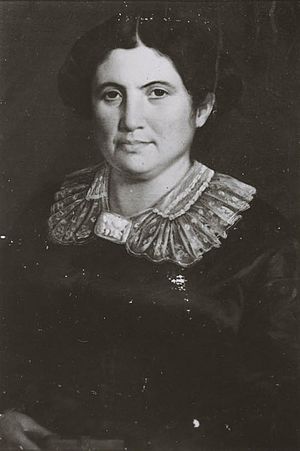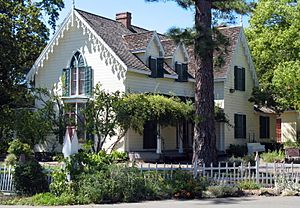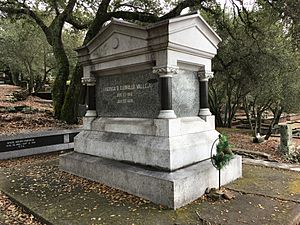Francisca Benicia Carrillo de Vallejo facts for kids
Quick facts for kids
Francisca Benicia Carrillo de Vallejo
|
|
|---|---|

Portrait of Francisca Benicia Carrillo de Vallejo by Stephen Shaw, 1856
|
|
| Born |
Francisca Benicia Carrillo
August 23, 1815 |
| Died | January 30, 1891 (aged 75) Sonoma, California, U.S.
|
| Resting place | Mountain Cemetery, Sonoma, California, U.S. |
| Nationality | Californio |
| Citizenship | Spain United States |
| Known for | The City of Benicia, California is named after her. |
| Spouse(s) | Mariano Guadalupe Vallejo |
| Parents |
|
| Relatives | José Antonio Romualdo Pacheco, Jr. |
Francisca Benicia Carrillo de Vallejo (1815-1891) was an important pioneer from California. She belonged to the famous Carrillo family of California and was married to Mariano Guadalupe Vallejo. Francisca was one of the first people to settle in Sonoma, California, a town started by her husband. She lived through the exciting Bear Flag Rebellion and later managed their family home, Lachryma Montis, until she passed away in 1891. The city of Benicia, California is even named after her!
Contents
Francisca's Early Life
Francisca Benicia Carrillo was born on August 23, 1815. Her birthplace was San Diego in Alta California. Her parents were María Ygnacia López de Carrillo and Joaquin Victor Carrillo.
On January 24, 1830, Francisca met a young soldier. His name was Mariano Guadalupe Vallejo. He had just arrived in San Diego. Francisca was 15 years old and Mariano was 23. Mariano spent two weeks getting to know Francisca. Then he left for Monterey.
They kept in touch by writing letters. On October 15, Mariano wrote to the President of Mexico, Anastasio Bustamante. He asked for permission to marry Francisca. Their parents had already agreed to the marriage. It took two years for the President to say yes.
On March 6, 1832, Francisca and Mariano were married. The wedding took place at the Presidio of San Diego. José María de Echeandía attended the wedding. He gave a toast, saying he had known Francisca since she was eight. He admired her good manners.
Leading the Vallejo Family
Moving to San Francisco
In February 1833, Mariano Vallejo became Commander of the Presidio of San Francisco. Francisca was pregnant with their first child. She traveled 800 miles from San Diego to San Francisco. She went to live with Mariano at the Presidio.
Mariano's brother, Salvador Vallejo, went with her. They also had an escort of 20 soldiers. The journey took four weeks. Salvador later married Francisca's sister, Maria de la Luz Carillo.
Their first son, Andronico Vallejo, was born on March 4, 1833. Sadly, he died in September. He was buried at Mission San Francisco de Asis. Their second child, also named Andronico, was born on April 28, 1834.
On May 1, 1834, Governor José Figueroa gave Mariano a new job. He was to build a fort north of San Francisco. This area would become Sonoma County. Mariano went to Mission San Francisco Solano to build the fort. This led to the founding of Sonoma, California. Francisca stayed in San Francisco with her son. They moved to Sonoma in the summer of 1835.
Life in Sonoma
Starting a Family in Sonoma
Francisca had her third child soon after arriving in Sonoma. It was a girl named Epifania Gertrudis, born on August 4, 1835. Francisca and Mariano would have 16 children in total. Six of them died at birth or during childhood.
The family lived in Casa Grande. This was a three-story home on the new Sonoma Plaza. Over twenty Native American servants helped run the household. Each child had a servant, and Francisca had two. The Vallejos also had a second home. It was in nearby Petaluma, called the Rancho Petaluma Adobe.
The Bear Flag Rebellion
Francisca was at Casa Grande during the Bear Flag Rebellion in 1846. American immigrants captured Sonoma for 25 days. Jacob P. Leese and Mariano Vallejo were taken prisoner. The rebels, called "Bears," put the Bear Flag on the Sonoma Plaza. They took control of the new town.
During this time, Francisca's brother, Ramón, was accused of a crime. He was said to have joined Juan Nepomuceno Padilla in killing two Bears. Their names were Thomas Cowie and George Fowler. Padilla and Ramón hid at nearby Rancho Olompali.
Francisca secretly sent weapons to Ramón, Padilla, and her mother. Her mother lived north of Sonoma and owned a rancho. The weapons included pistols, gunpowder, and sabers. An Indian servant named Gervasio delivered them. Ramón said he had nothing to do with the killings. He swore that Padilla had ordered the men's deaths.
The U.S. Navy removed the Bear Flag on July 9. They raised the twenty-seven star flag of the United States instead. Francisca was happy about the American flag. She wrote a letter to Mariano, who was still imprisoned at Sutter's Fort. She wrote about "great celebrations." She said she was "cheering heartily" and waving handkerchiefs.
Francisca celebrated at Casa Grande. She hosted American servicemen there. She also watched the new American flag carefully to make sure it stayed up. A soldier who visited Casa Grande called Francisca "very fat" and "having evidence of much beauty." He thought she seemed "contented and happy."
In Sonoma, Francisca's closest friend was Rosalía Leese. Rosalía was Mariano's sister and Jacob Leese's wife. Even after the Bear Flag was removed, some rebels stayed in Sonoma. Both Francisca and Rosalía were upset that these "Bears" were still around. Francisca called the Bears "disconsolate" in her letter to Mariano. She wished the U.S. Navy had arrived sooner. She felt that many unnecessary deaths, like Cowie and Fowler's, could have been avoided.
Life After the Revolt

In May 1847, Mariano Vallejo gave a large piece of land to Semple and Thomas O. Larkin. This land would become Benicia, California. Mariano wanted to name the new city "Francisca." But Yerba Buena changed its name to San Francisco. So, they named the city "Benicia" to avoid confusion. After this, people in Benicia called Francisca Doña Benicia.
The Vallejos built Lachryma Montis in 1850. It was just blocks from the Sonoma Plaza. This home would be their last home until they died. Francisca hosted many grand parties at Lachryma Montis. She entertained important people like David Glasgow Farragut, William T. Sherman, Ulysses S. Grant, and Edwin Bryant.
As the Vallejo family's money decreased in the 1860s, they started growing and selling food. They grew figs, apples, and grapes. They also raised chickens for eggs. Francisca managed the sales of produce and eggs. She sent them to San Francisco and all over Sonoma. She sold them to bakeries, restaurants, and hotels.
Francisca used to have many servants. But now she managed Lachryma Montis with little help. She handled the cleaning, gardening, and other tasks. Only two cooks worked in the kitchen.
Francisca and Mariano's relationship faced challenges during this time. This was due to money problems and Mariano being away from Sonoma often. He spent time in Watsonville, California helping his nephew with his rancho. When Mariano returned to Sonoma in 1869, his brother, Salvador Vallejo, moved in. This caused more difficulties, as Francisca did not like Salvador.
Francisca moved to Vallejo in late 1869 to live with her daughter Fannie. Mariano stayed at Lachryma Montis. Francisca returned to live with Mariano in late 1870.
Later Life and Passing
Mariano Guadalupe Vallejo died on January 18, 1890. Francisca died at Lachryma Montis on January 30, 1891. She is buried next to Mariano at Sonoma's Mountain Cemetery.
How People Saw Francisca
Edwin Bryant described Francisca as "a lady of charming personal appearance." He said she had "natural grace, ease, and warmth." Her sons said she was "level-headed" and supported women's rights. Historian Alan Rosenus called her "a proud, somewhat conventional woman." He noted she was aware of her social standing.
Francisca was very religious and believed strongly in Catholic teachings. She was also quite emotional. She often wrote direct and sensitive letters to Mariano when he was away.
Francisca enjoyed luxury goods. She wore dresses and accessories made from expensive silks and velvet. These were imported from France. When her daughter, Adela, was getting ready to marry, Francisca took her to San Francisco. The two women spent a lot of money shopping and staying at a fancy hotel.



